Treatment of Goodwill:
The outgoing partner is entitled to his share of goodwill at the time of retirement/death because the goodwill has been earned by the firm with the efforts of all the existing partners. Therefore, goodwill is valued as per the agreement, at the time of retirement/death.
Due to the retirement/death of any partner, the continuing partners make again because the future profit will be shared only between the continuing partners. Therefore, the continuing partners should compensate the retiring/deceased partner for his share of goodwill in the gaining ratio.
The accounting treatment for goodwill depends upon whether the goodwill already appears in the books of the firm or not.
When Goodwill does not Appear in the Books: When Goodwill does not appear in the books of the firm, there are four following ways to compensate the retiring partner:
(a) Goodwill is raised at its full value and retained in the books:
Goodwill A/cDr.
To All Partner’s Capital A/c’s
(including retiring/deceased partner)
(For the goodwill raised at its full value and credited to capital A/c’s of a ’1 partners in their old profit sharing ratio)
The full value of goodwill will appear in the new balance sheet.
(b) Goodwill is raised at its full value and written off immediately:
If it is decided that the goodwill will not appear in the balance sheet of the reconstituted firm, then the following journal entries are required:
1. Goodwill A/c Dr.
To All Partner’s Capital A/c’s (For raising of Goodwill and credited to all partners capital A/c’s in their old profit sharing ratio)
2. Continuing Partner’s Capital A/c’s Dr.
To Goodwill A/c
(For written-off goodwill between continuing partners in their new profit sharing ratio)
(c) Goodwill is raised to the extent of retired/deceased partner’s share and written off immediately:
1. Goodwill A/c Dr.
To Retiring/Deceased Partner’s Capital A/c (For the goodwill raised by share of outgoing partner)
2. Continuing Partner’s Capital A/c’s Dr.
To Goodwill A/c
(For the goodwill written off between the continuing partners in their gaining ratio)
(d) No Goodwill account is raised at all in the firm’s books: If the outgoing partner’s share of goodwill is adjusted in the capital accounts of the continuing partners without opening a goodwill account, the following entry will be required:
Continuing Partner’s Capital A/c’s Dr.
To Outgoing Partner’s Capital A/c (For the share of outgoing partner in the goodwill adjusted through capital accounts in the gaining ratio)
The following example clears the above accounting treatment of Goodwill at the time of retirement/death:
Ram, Shyam and Mohan are partners in firm sharing profits and losses in the ratio of 5: 3: 2. Shyam retires. The goodwill of the firm is valued at Rs. 1,40,000 and the remaining partner’s Ram and Mohan continue to share profits in the ratio of 5:2. The following journal entries passed under various alternatives shall be as follows:
If goodwill is raised at full value and retained in books:
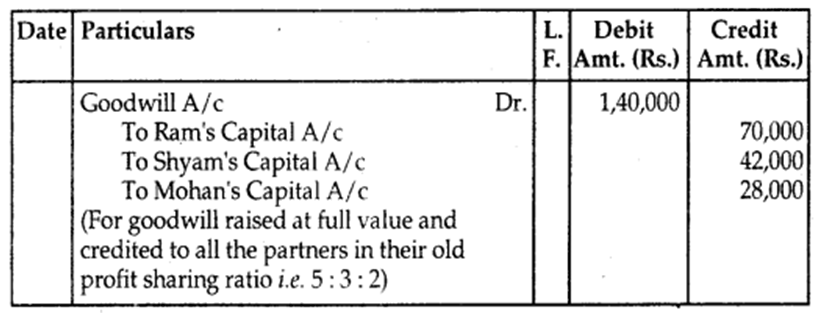
If goodwill is raised at full value and written off immediately:
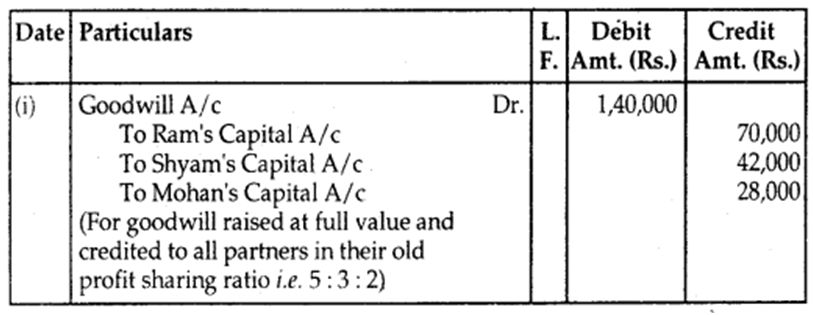

If goodwill is raised to the extent of the retiring partner’s share and written off immediately:
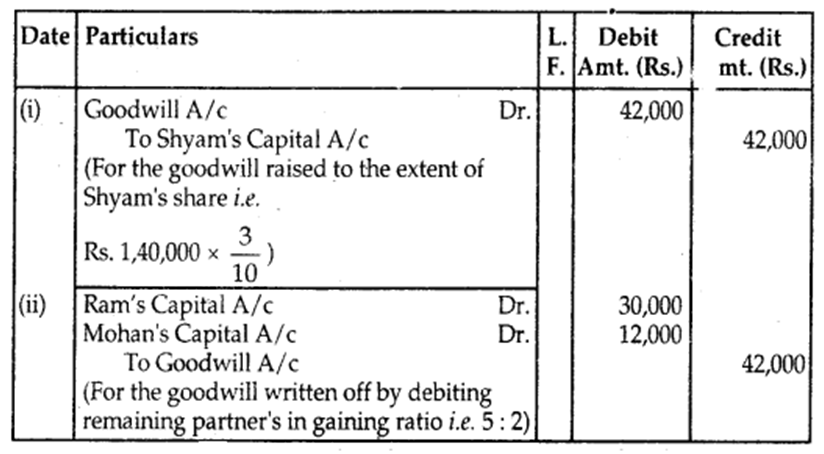
No goodwill account is raised at all in the firm’s books:
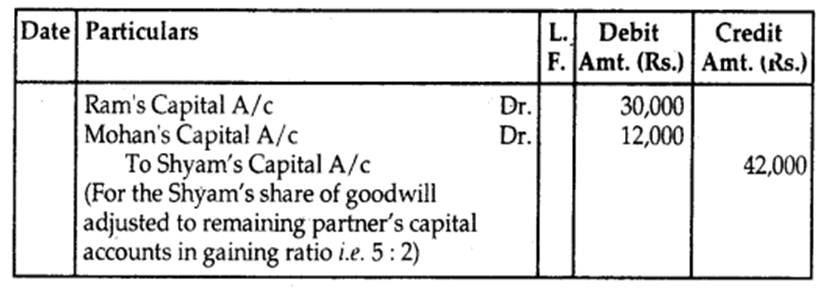
When Goodwill is already appearing in the books:
(a) If the value of goodwill appearing is equal to the current value of goodwill of the firm:
Normally, no adjustment is required if both the amounts are the same. Because goodwill stands credited in the accounts of all the partners including the retiring one.
(b) If the book value of goodwill is lower than its present value:
If the book value is less than the present value, the difference will be debited to the goodwill account and credited to the old partner’s capital accounts in their old profit sharing ratio.
Goodwill A/c Dr.
To All Partner’s Capital A/c’s (individually)
(For goodwill raised to its present value)
(c) If the book value of goodwill is more than the agreed or present value:
If the book value of goodwill is more than the present value, the difference will be debited to All partner’s capital accounts in their old profit sharing ratio and credited to the goodwill account.
All Partner’s Capital A/c’s (individually) Dr.
To Goodwill A/c
(For goodwill brought down to its present value)
Alternatively,
1. First, write off the existing goodwill that appears in the books:
All Partner’s Capital A/c’s (individually) Dr.
To Goodwill A/c
(For write-off goodwill to all partners in old profit sharing ratio)
2. Adjust retiring partner’s share of goodwill through capital A/c’s
Remaining Partner’s Capital A/c’s Dr.
To Retiring/deceased Partner’s Capital A/c
(For goodwill share of retiring/deceased partner adjusted to remaining partner’s Capital A/c’s in their gaining ratio)
Hidden Goodwill: If the firm has agreed to settle the retiring/deceased partner by paying him a lump sum, then the amount paid to him in excess of what is due to him based on the capital accounts balance after making all adjustments like accumulated profits and losses and revaluation profit or loss etc. shall be treated as his share of goodwill known as hidden goodwill.
- Books Name
- Vision classes Accountancy Book
- Publication
- Vision classes
- Course
- CBSE Class 12
- Subject
- Accountancy
Treatment of Goodwill
The retiring or deceased partner is entitled to his share of goodwill at the time of retirement/death because the goodwill has been earned by the firm with the efforts of all the existing partners. Hence, at the time of retirement/death of a partner, goodwill is valued as per agreement among the partners the retiring/ deceased partner compensated for his share of goodwill by the continuing partners (who have gained due to acquisition of share of profit from the retiring/ deceased partner) in their gaining ratio. The accounting treatment for goodwill in such a situation depends upon whether or, not goodwill already appears in the books of the firm.
When goodwill does not appear in the books
When goodwill does not appear in the books of the firm, credit in given to the retiring partner for the share in goodwill by debiting the goodwill account to gaining partners capital accounts (individually) in their gaining ratio. The journal entry is :
Gaining Partners Capital A/c Dr. (Individually) To Retiring Partners Capital A/c
(Share in goodwill of retiring partner adjusted)
Let us take an example to understand the treatment of goodwill.
A, B and C are partners in a firm sharing profits in the ratio of 3:2:1 B retired and the value of goodwill of the firm in valued at Rs. 60,000. A and C continue the business sharing profits in the ratio of 3:1. The journal entry for adjustment of goodwill will be :

(B's share of goodwill adjusted to remaining partners' capital accounts in their gaining ratio)
It may also happen that as a result of decision on the new profit sharing ratio among the remaining partners, a continuing partner may also sacrifice a part of his share in future profits. In such a situation his capital account will also be credited along with the retiring/deceased partner’s capital account in proportion to his sacrifice and the other continuing partners’ capital accounts will be debited based on their gain in the future profit ratio.
Revision 6
Keshav, Nirmal and Pankaj are partners sharing profits and losses in the ratio of 4 : 3 : 2. Nirmal retires and the goodwill is valued at Rs. 72,000. Keshav and Pankaj decided to share future profits and losses in the ratio of 5 : 3. Record necessary journal entries.
Solution
Journal

Working Notes
Vimal’s share of goodwill = Rs. 72,000 × 3/9 = Rs. 24,000
Calculation of Gaining Ratio
Gaining Share = New Share – Old Share
Keshav’s Gaining Share = 5/8 – 4/9 = 13/72
Pankaj’s Gaining Share = 3/8 − 2/9 = 11/72
Hence, Gaining Ratio between Keshav and Pankaj is 13:11 i.e. 13/24 : 11/24
Revision 7
Jaya, Kirti, Ekta and Shewata are partners in a firm sharing profits and losses in the ratio of 2 : 1 : 2 : 1. On Jaya’s retirement, the goodwill of the firm is valued at Rs. 36,000. Kirti, Ekta and Shewata decided to share future profits equally. Record the necessary journal entry for the treatment of goodwill without opening ’Goodwill Account’.
Solution
Books of Kirti, Ekta and Shewata
Journal

Working Notes
1. Jaya’s Share of Goodwill
= Rs. 36,000 × 2/6 = Rs. 12,000
2. Calculation of Gaining Ratio
Gaining Share = New Share – Old Share
Kirti’s Gain = 1/3 – 1/6 = 2/6 − 1/6 = 1/6
Ekta’s Gain = 1/3 − 2/6 = 2/6 − 2/6 = 0 (Neither Gain nor Sacrifice)
Shewata’s Gain = 1/3 − 1/6 = 2/6 − 1/6 = 1/6
Hence, Gaining ratio between Kirti and Shewata 1/6 : 1/6 = 1:1
Revision 8
Deepa, Neeru and Shilpa were partners in a firm sharing profits in the ratio of 5 : 3 : 2. Neeru retired and the new profit sharing ratio between Deepa and Shilpa was 2 : 3. On Neeru’s retirement, the goodwill of the firm was valued at Rs. 1,20,000. Record necessary journal entry for the treatment of goodwill on Neeru’s retirement.
Solution
Books of Deepa and Shilpa
Journal

Working Notes
1. Calculation of Gaining Ratio
Gaining Share = New Share – Old Share
Deepa’s Gaining Share = 2/5 – 5/10 = 4/10 − 5/10 = - 1/10 = (1/10) i.e., Sacrifice.
Shilpa’s Gaining Share = 3/5 − 2/10 = 6/10 – 2/10 = 4/10 i.e., Gain
2. Hence, Shilpa will compensate both Neeru (retiring partner) and Deepa (continuing partner who has sacrificed) to the extent of their sacrifice worked out as follows:
Deepa’s Sacrifice = Goodwill of the firm × Sacrificing Share
= Rs. 1,20,000 × 1/10 = Rs. 12,000
Neeru’s (Retiring Partner’s Sacrifice) = Rs. 1,20,000 × 3/10 = Rs. 36,000.
Revision 9
Hanny, Pammy and Sunny are partners sharing profits in the ratio of 3 : 2 : 1. Goodwill is appearing in the books at a value of Rs. 60,000. Pammy retires and at the time of Pammy’s retirement, goodwill is valued at Rs. 84,000. Hanny and Sunny decided to share future profits in the ratio of 2:1. Record the necessary journal entries.
Solution
Books of Hanny and Sunny
Journal
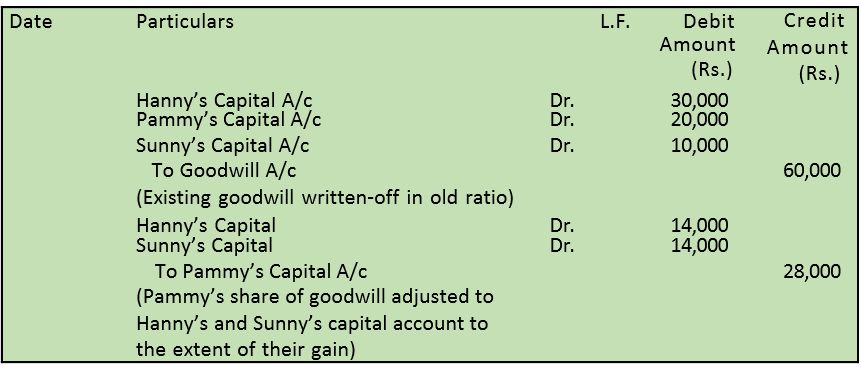
Working Notes
(i) Pammy’s share of current value of goodwill 1/3 of Rs. 84,000
= 1/3 × 84,000 = Rs. 28,000
(ii) Gaining Share = New Share – Old Share
Hanny’s Gaining Share = 2/3 − 3/6 = 1/6
Sunny’s Gaining Share = 1/3 – 1/6 = 1/6
This gaining Ratio of Hanny and Sunny is 1/6 : 1/6 = 1:1
Hidden Goodwill
If the firm has agreed to settle the retiring or deceased partner’s account by paying him a lump sum amount, then the amount paid to him in excess of what is due to him, based on the balance in his capital account after making necessary adjustments in respect of accumulated profits and losses and revaluation of assets and liabilities, etc., shall be treated as his share of goodwill (known as hidden goodwill).
For example, P, Q and R are partners in a firm sharing profits in the ratio of 3:2:1. R retires, and the balance in his capital account after making necessary adjustments on account of reserves, revaluation of assets and liabilities workout to be Rs. 60,000, P and Q agreed to pay him Rs. 75,000 in full settlement of his claim. It implies that Rs. 15,000 is R’s share of goodwill of the firm. This will be debits to the capital accounts of P and Q in their gaining ratio (3:2 assuming no change in their own profit sharing ratio) and crediting R’s capital Account as follows:


 SUDIP CHAKRABORTY
SUDIP CHAKRABORTY
